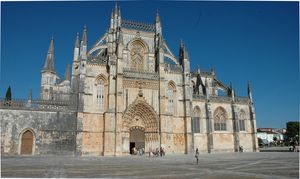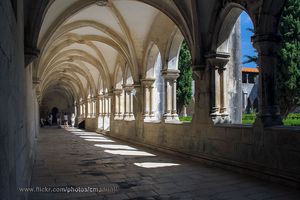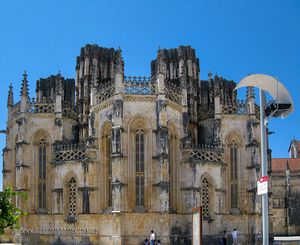
Batalha Monastery, Portugal
Do not miss the chance to visit Monastery of Santa Maria da Vitoria or Monastery of Batalha during your visit to Portugal.
The Monastery of Santa Maria da Vitória, widely known as Batalha Monastery, is a majestic building, declared World Heritage by the UNESCO. Combining Manueline and Gothic styles, it was built in the 14th century to carry out the promise D. João I did to the Virgin in case they won the Castilians in the Battle of Aljubarrota, in 1385.
In this battle, 6,500 Portuguese defeated an army of 30,000 Castilians, leaded by Juan I of Castilla, who claimed João D’Avis’ throne for himself. Portuguese were commanded by Nuno Álvares Pereira and supported by hundreds of English soldiers. This general played a very important role during the Portuguese Crisis that took place between 1383 and 1385. Nowadays, it is possible to see a honorific equestrian statue of himself.
João prayed for Virgin Mary’s help, and vowed to build this monastery in exchange for victory. Three years later, he kept his promise and began with the construction of this monumental abbey.
In 1434, most of the blasing Gothic Monastery (the church, the Sala do Capítulo Hall, the Capela do Fundador (Founder’s Chapel), and the Royal Cloister) had been built. Despite this, the true jewels of the monuments are the Manueline details, thanks to the incorporations made in the 15th and 16th centuries. Its construction just stopped in the mid-16th century, when João III managed to stop building the Convent of Christ in Tomar.
Outside:
The outside of this impressive building in ochre has numerous pinnacles, flying buttress, parapets and balustrades, as well as Gothic and blasing carved windows; and octagonal chapels and columns. The Occidental arcade has overlapping arches where angels, apostles, prophets, saints and Christ can be seen.
Interior:
The interior has a simple Gothic vaulted style of big dimensions. It is illuminated by colourful stained glasses.
As soon as you cross the entrance, on the right, it is possible to find the Chapel of Fundador, an incredibly square tall hall covered by a star cupola illuminating the room.
Claustro Real (Royal Cloister):
Built by Afonso Domingues, it is a sober cloister Gothic in style, despite the added Manueline elements by Diogo de Boitaca. Each one of its arches is an elaborated Manueline carving ball. Three stunning cypresses located in the central patio, reproduce the shape of the Gothic towers of the Sala do Capítulo Hall.
Dom Afonso V Cloister:
Designed by the master Fernão de Évora, this cloister has a more sober Gothic style.
Sala do Capítulo Hall:
Dating back to the 15th century, it is located to the East of the Claustro Real (Royal Cluster). It has a gorgeous 16th century stained glass. Its enormous vault suspended 19-metres high, was considered so dangerous that for its construction only death row prisoners worked on it.
The hall hosts the tombs of unknown soldiers, which are flanked by a permanent honour guard.
Capelas Imperfeitas (Flawed Chapel):
These unfinished chapels without roof, are one of the most surprising things in Batalha. They just can be reached from the exterior of the monastery. It is octagonal and has seven chapels, commanded by Dom Duarte, son of D. João I, in 1437.
Afterwards, it was enlarged with extraordinary Manueline elements by the architect Mateus Fernandes. Although they were never completed, their exquisite decoration is amazing. It is worth to visit its 15-metres tall porch, with its flowers, snails, and different plant motifs carved in the stone. Dom Duarte and his wife’s tomb is located in front ot the door.
The old refectory and kitchen host the Museum of Oferendas ao Soldado Desconhecido.
More information:
Location:
Mosteiro da Batalha, Batalha.
Ticket price:
Single Ticket: 6 €.
Combined ticket for different monuments (Alcobaça, Batalha, Christ Convent): 15 €.
Free entrance all Sundays and Bank holidays until 14h00.
Available discounts for retirees, Youth Card, families and ex-combatants.
Opening hours:
From April to September from 9h00 to 18h00.
From October to March from 9h00 to 17h00.
Closed on 1st January, 1st May, Good Friday, Easter Sunday and 25th December.
Telephone:
(+351) 244 765 497.
Recommended Excursions:
Mapa Interactivo:
More cities in the Lisbon Region:
Why "Portugal Travel"?
Portugal Travel is an organization of Portuguese agencies whose objectives are:
- ✓ To make Portugal, its culture and its heritage known.
- ✓ To promote sustainable tourism.
In collaboration with:
Escola Superior de Hotelaria e Turismo do Estoril
Turismo de Portugal
Copyright PortugalTravel.org © - All rights reserved.








